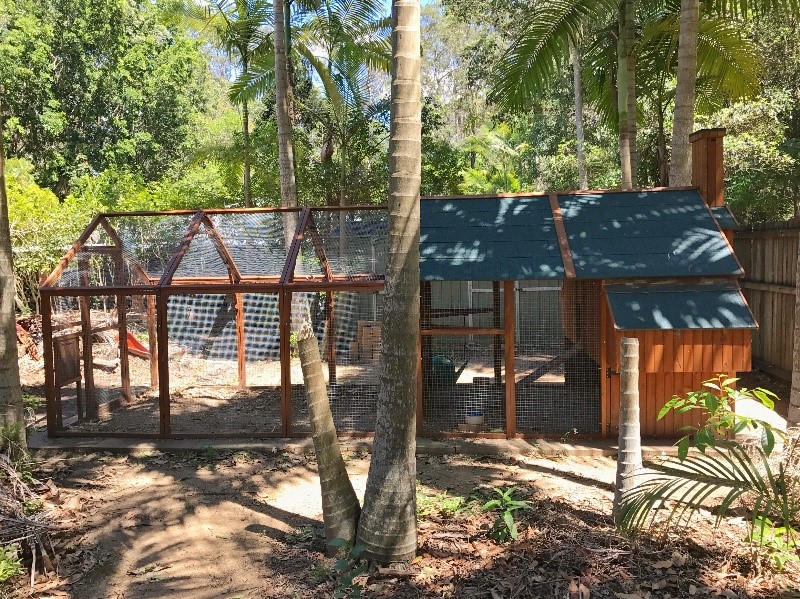Types of housing for chickens
Chicken enclosures generally consist of a coop (a solid structure that houses the chickens at night) and an external run.
The coops for night time housing of the chickens can be:
- Permanent, with the chickens housed on deep litter – usually on a concrete slab covered with a deep layer (10-15cms) of litter (sawdust, shavings, or hay) that is changed regularly.
- Permanent, with the chickens housed in enclosures inside a shed. This kind of set up is often used for show poultry or breeding birds.
- Portable/moveable coops – often an A-frame coop and enclosure with wheels at one end that can be moved around the garden or lawn every few days. This minimises damage to the grass, while also minimising the build-up of pathogens such as intestinal parasite ova.
All of these coops must have a run attached, and/or the birds can be allowed free range during the day (and locked up at night).

Size
Chickens kept at low stocking densities (i.e., with more space per bird) have been shown to have increased activity and reduced lameness, with fewer problems with bumblefoot (pododermatitis – an infection on the sole of the foot). These birds are less fearful, can shelter from climate extremes, and display fewer behavioural issues such as feather damage.
If chickens are allowed to roam large garden spaces or open land and are only kept in the housing at night for protection, during egg laying and brooding, and during poor weather, then smaller coops (such as the minimum recommendations below) can be suitable. However, if chickens are kept within the coop or run for most of the time, the enclosure must be significantly larger to allow for nesting, wing flapping, running, scratching and other natural chicken behaviour. Each chicken needs space to flap their wings, move about, and build a nest as an absolute minimum.
Current recommendations are for a minimum floor/run area of 3 m2 for housing up to six bantams or three large birds. Additional birds will require an increase in enclosure size of at least 0.4 m2 for every large bird and 0.3 m2 for every small bird. Note that these recommendations are for a minimum-sized coop and run – if you can go larger, the birds will appreciate it.
Perches
Chickens instinctively seek high roosts to avoid predators while they sleep. Roosting perches made of 75mm x 50mm dressed timber placed at least 50cm from the floor are usually appreciated by chickens. Plastic perches are not recommended as they can become brittle with age and, more importantly, they are not good for the chickens’ feet. At least 15cm of roost space per bird should be provided.
Some pointers on height:
- Heavier chickens should have perches at a slightly lower level (30cm).
- Bantams love to fly so their perches can be positioned much higher.
- Old or disabled chickens may need a perch that is much lower to the ground. A perch that is 5-10cms off the ground may be preferable.
- If your flock is mixed (i.e., includes different types of bird), the height of the perches can vary, rather like a staircase or ladder configuration. Height wise in a ladder configuration you could have perches at 10, 20, 30, 40, and 50cms. This gives the birds ample room, and they can choose where they want to perch.
Perches should not:
- sit above drinkers and feeders or open top nests because of faecal contamination below the perch
- block entrances, or
- be placed directly on front of ventilation points that may be in draughts in winter months.
When raising baby chicks, providing a small roosting bar within the brooder will help to encourage roosting habits that will carry over when juvenile chickens are moved into the coop.
Nest boxes
Nest boxes are used by the hens to lay their eggs. There are several considerations to keep in mind.
- How many boxes should be provided? As chickens lay their eggs at different times of the day, it is not unusual for them to time share a box. At least one box should be provided for every 2-4 hens.
- What size box should be used? As a rule, nest boxes that are 30cm x 30cm are suitable. If you happen to have a number of breeds of different sizes, provide a box to suit the largest hens.
- What design works best? The roof should be slanted, to prevent the birds roosting (or even laying) on top of the box. The front of the box should be wide enough for the hens to enter easily. A closable hatch at the back of the box allows easy egg collection without disturbing the hen.
- Where should the box be placed? The boxes should be sheltered within the coop for the comfort of egg-laying hens. They should be mounted on the cool side of the coop preferably 60cm to 90cm off the ground, not too high from the roosting regions.
- What nesting material should be used? This can be shavings, straw, or shell grit, to a depth of 75mm, and should be kept clean and dry.
References
Colville-Hyde A, Poland G (2019) Husbandry . In: BSAVA Manual of Backyard Poultry Medicine and Surgery. British Small Animal Veterinary Association, pp 27–38
Karcher D (2021) Basic housing and management. In: Greenacre C, Morishita T (eds) Backyard Poultry Medicine and Surgery: A Guide for Veterinary Practitioners. John Wiley & Sons, Inc, pp 45–55
